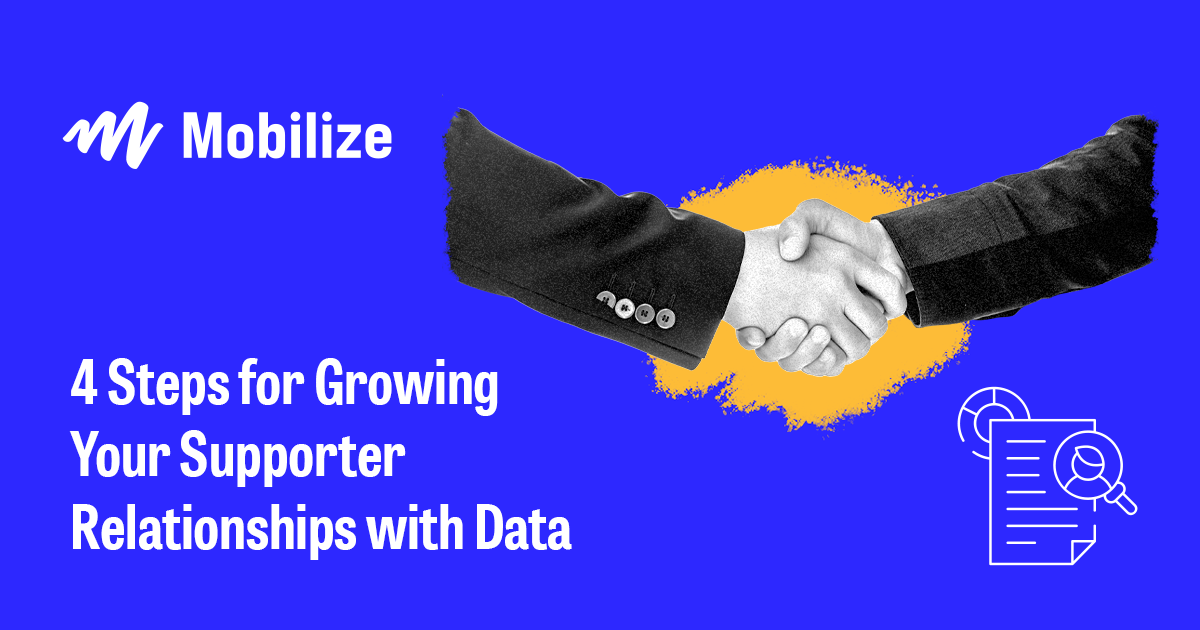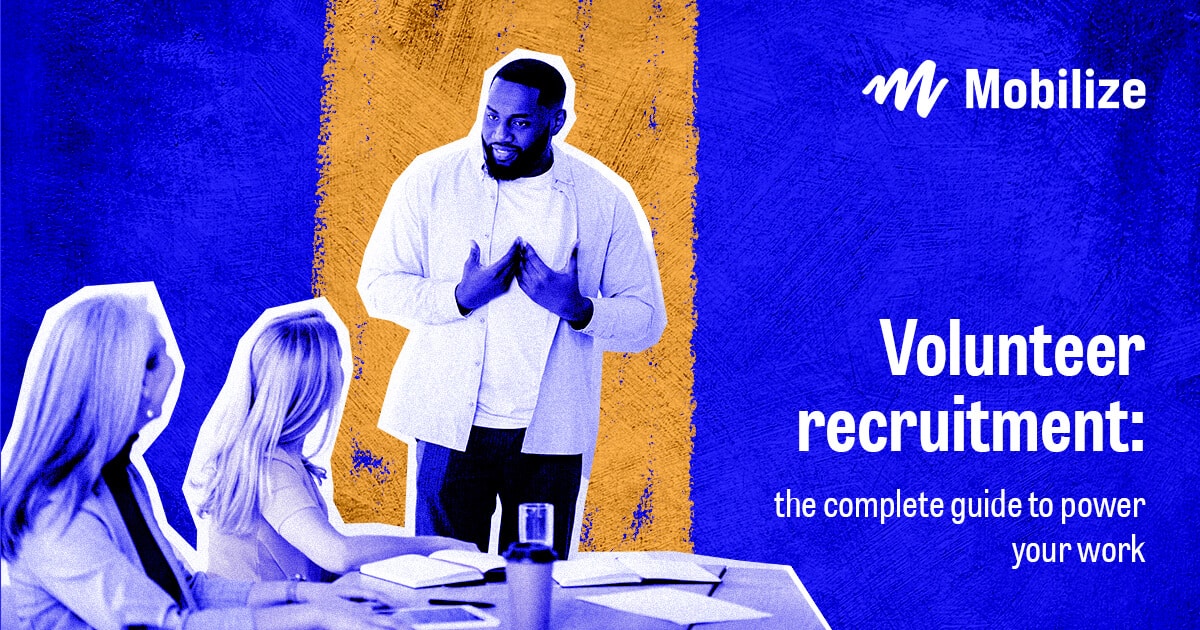

Best Practices
Best Practices
After a challenging year, investing in your relationships is a smart move for any organization. Learn how with these four steps.

This guest post was written by the digital engagement experts at Soapbox Engage.
The past year was undoubtedly one of the busiest that your organization has ever experienced. The COVID-19 pandemic, mass social justice movements, a turbulent election cycle, and an uncertain economy all contributed to a 2020 full of challenges, surprises, and a few inspiring developments.
Supporters of all types of nonprofits have shown up in full force to keep driving their favorite missions forward. For example, on the Mobilize platform alone, 4.2 million individual volunteers took 15 million actions for nonprofits, political campaigns, and other organizations in 2020. Now that’s some impressive engagement data. Despite (or because of) a year of challenges, many supporters are more eager than ever to get involved in bettering their communities and society as a whole through donations, volunteering, and advocacy work.
Your own organization’s database is hopefully fuller than ever with valuable engagement data from all of the virtual fundraising campaigns, advocacy strategies, and marketing pushes you conducted over the course of 2020. For many missions, the pandemic, election, and year-end rush resulted in surges of new support and exposure to broad new audiences.
If your nonprofit welcomed any number of new supporters in the past year, now is the time to ensure you’re actively taking steps to grow those relationships. By putting your 2020 engagement and fundraising data to work, you can strengthen all of your strategies going forward and, most importantly, grow your relationships to retain more support over time.
Let’s walk through the core steps you’ll need to follow when reviewing your data and using it to help build stronger supporter relationships:
If your organization hasn’t yet built out concrete strategies for data-driven relationship building, this overview is the perfect place to start. Let’s get started.
To strengthen your relationships with supporters, you’ll first need a solid foundation of data to build on. Start by ensuring that you’re currently capturing the right data. Modern donation and registration tools should make it easy to automatically gather this information, so take some time upfront to double-check that your donation and sign-up pages are pulling their weight.
Data that will help you build supporter relationships will generally fall into three categories:
Integrations between your software platforms will drastically simplify the process of collecting, analyzing, and actually using your data to develop supporter relationships. These connections allow data generated by supporter-facing tools to flow directly to your database or CRM, where it’s automatically sorted into relevant individual profiles.
The rising importance of integrations and smooth dataflows are part of the reason why modular, cloud-based CRM platforms are becoming popular choices for the nonprofit sector. For instance, the broad app ecosystem and open-source customizability of Salesforce and Microsoft Dynamics for Nonprofits have made them major players in the space.
Regardless of the exact platforms you use, it’s important to explore your options when it comes to integrations. Many modern tools now include pre-built integrations with other leading platforms that can be easily turned on to begin flowing data to the right places.
Then, once you’ve got a reliable data infrastructure in place, you’ll need to ensure you’re actively managing all of the incoming information. This walkthrough from DNL OmniMedia explores how to properly store, maintain, and use your supporter data. The biggest takeaway to keep in mind is that your data should be regularly screened for inaccuracies, redundancies, and usefulness. Taking steps to regularly maintain your database will deliver much more value over time as you develop new relationship-building strategies.
Once you’ve ensured that you’re gathering and organizing your supporter data properly, it’s time to dig deeper. Combing through your entire database to find insights is a huge task, so you’ll need to simplify things by sorting your supporters into discrete segments. Your CRM should allow you to easily group supporters by specific characteristics that they share, like demographic information, average donation amount, length of engagement with your organization, or previous event attendance.
Data segmentation makes it much easier to actively identify engagement trends and then roll out targeted strategies for addressing or making the most of them. For instance, supporter segments can be invaluable for:
Remember that segmentation is an ongoing process. With every new campaign or message, there’s a new opportunity to better target your efforts by studying supporter segments. And after your campaigns and events end, be sure to study your performance to proactively find trends in your data. This will allow you to continually refine your segmentation strategies.
One important consideration to keep in mind is that effective segmentation can be a challenge when using some tools. Free fundraising software (even from reputable providers) might not always include the robust data reporting features or integrations you’ll need to make segmentation a smooth and ongoing part of your approach. Always take some time to explore your integration options or plan ahead to proactively handle data reporting from any platforms that won’t mesh seamlessly with your database.
With a solid foundation of segmentation tactics and a growing database or volunteer management solution, you’ll be able to take segmentation a step further by developing supporter personas and outlining specific supporter journeys. As you gather more engagement data from more supporters, make forward-thinking inferences about who your supporters are, how they engage with your organization, and how you can best encourage them to grow their engagement.
For example, if your most dedicated volunteers are of a certain age and first found you on social media, lean into it by building a persona or journey around those insights! Then, use this persona to anchor your future recruitment and engagement efforts, steering new volunteers toward what you know will keep them engaged.
Multichannel marketing involves engaging your audience from multiple angles: social media, emails, text messages, blog posts, direct mail, and more. As your segmentation tactics and supporter personas come into sharper focus, think specifically about the multichannel messages and outlets you’ll use to proactively grow your relationships.
Aim to develop a concrete engagement strategy for each supporter persona or journey.
This will give your marketing a new level of focus, targeted to what you know draws each type of supporter to your mission, the types of next steps you want them to take, and where you eventually want them to end up. When it comes to messaging, more specificity and personalization tends to generate much stronger results in terms of conversions, whether they’re donations, sign-ups, or whatever next step you want your audience to take.
What does this look like in practice? Email streams are a perfect example, and they’re relatively easy to roll out. For instance, for your mid-level donor persona, you may find that these supporters tend to be drawn to the same types of campaigns and events. When a new donor makes an online gift of $100 or more, you might trigger a dedicated email stream to steer them towards the engagement opportunities you’ve defined as relevant for that persona. Your emails might follow a structure like this:
Put some careful thought into the exact strategies and next steps that you’ll offer each supporter persona based on the journey you want them to take with your organization. Registering for events, giving donations, participating in volunteering opportunities, launching a peer-to-peer campaign, or simply signing up for more updates are all valuable choices.
However, remember to always anchor your messages with concrete calls to action (CTAs) that clearly state what you want your reader to do next. For emails, these CTAs will often take the form of clearly labeled buttons that link directly to the relevant landing page. Explore this Soapbox Engage guide for best practices and examples of effective nonprofit CTAs.
Finally, to support all the hard work you’ve put into developing segments and multichannel supporter journeys, you’ll need to put together concrete follow-up strategies. These thank-you messages should aim to accomplish two things. Ensure all of your messages:
Modern donation and volunteer management software should make it easy to configure and then automatically trigger these types of follow-up communications. Seamless follow-up will save your team time and provide the added benefit of generating even more engagement data as recipients open your emails and text messages and click through using your CTAs!
The biggest takeaway to keep in mind is that your thank-you and follow-up messages should serve as the critical link between supporters’ initial interactions and the marketing journeys you’ve developed. You definitely don’t want to let this first opportunity go to waste.
Additionally, don’t forget to offer new ways for supporters to engage with your organization over time. Only promoting the same volunteer opportunities to your volunteers or fundraising campaigns to your donors can risk boring them or (worse) making them feel that you’re only interested in their labor or wallets. Consider how your different supporter journeys might intersect, such as with donors signing up to volunteer, advocates attending a range of new events, or volunteers taking on new training opportunities.
Proactively show all of your supporters that you value their contributions and want them to also get value from your relationship.
2020, while full of challenges, created new and unique opportunities for collaboration and relationship-building between organizations and their supporters. Keep strengthening and developing those relationships in the new year!
For many mission-driven organizations, the pandemic and other events resulted in significant surges of support, so strategically growing those relationships will be a natural way to strengthen your position in 2021. And even if your contact list didn’t see significant growth in the past year, that’s all the more reason to double-down on showing your supporters you want them to stay engaged with your mission. Best of luck!

Best Practices

Best Practices

Best Practices